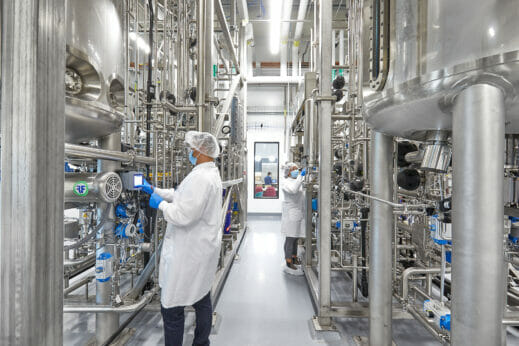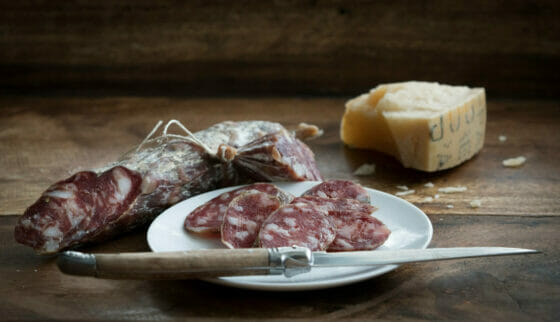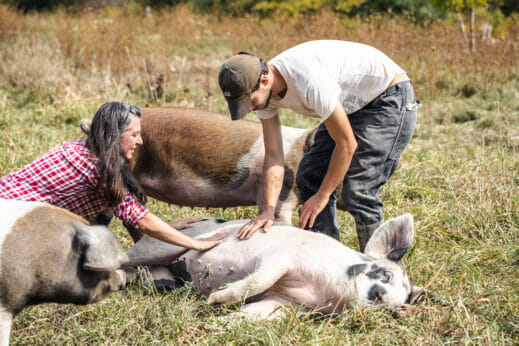Although the potential of cellular agriculture remains largely unfulfilled, Italy has moved to preemptively ban cultured meat products in a bid to preserve its cultural heritage.

Cultured meat. Cultivated meat. Clean meat. Synthetic meat. Lab-grown meat. Frankenmeat. These are just a few of the names used to describe the products of cellular agriculture, an emerging field of food production that makes use of cell cultures.
“The nomenclature changes with the marketing decisions of industry actors,” says Benjamin Aldes Wurgaft, author of Meat Planet: Artificial Flesh and the Future of Food, who notes that these actors—including food startups and environmental nonprofits—choose their words carefully in the hopes of winning consumer acceptance. (Wurgaft prefers “cultured meat” due to its relatively neutral proximity to the technology that defines it.)
In 2013, Dutch scientist Mark Post presented the first cultured meat product, a hamburger made possible by the financial support of American entrepreneur Sergey Brin. A decade later, cultured meat (by any name) still is not for sale on supermarket shelves.
It is also still pending approval by the United States Department of Agriculture, despite some confusion in the media over the matter. In November of 2022, Upside Foods, a cultured meat producer based in Berkeley, California, received what is known as a “No Questions Letter” from the United States Food and Drug Administration. Wurgaft explains that this has since been “treated as regulatory approval in the media, when in fact it means that the FDA simply doesn’t have any questions to ask about the process.”

A cultivation room at Upside Foods’ Engineering, Production & Innovation Center. (Photo via Upside Foods)
With or without government approval, leaders in the field continue to doubt the scalability of cultured meat. The result, Wurgaft says, is a “bizarre situation in which we have plants in the Bay Area shutting down while others are opening saying they will have a product very soon.”
Nevertheless, a State of the Industry Report published in February by the US-based nonprofit organization The Good Food Institute reported that the cellular agriculture industry now comprises 156 companies working in 26 countries and is expected to continue growing, thanks to the investment of $896 million in 2022.
The industry, however, will not continue its growth in Italy, which, as of March 27, 2023, has taken action to become the first country to formally ban cultured meat products within its national borders. In a press release about the ban, the Italian government claims it is acting in the interest of “preserving the agricultural and culinary heritage” of Italy.
In the weeks since the announcement of the ban, its opponents—both in Italy and around the world—have vocalized their support for cultured meat on the grounds that it offers meat without slaughter and the reduction of pollution associated with industrial animal agriculture. While inspirational, the promises of the cultured meat industry remain aspirational. They also tend to omit the fact that this form of food production is not entirely harmless. Cultured meat makes no claims of being wholly vegan, but its proponents rarely advertise the details of its creation, which requires blood from a cow fetus in addition to cells from a live animal. Research by Frontiers also demonstrates that, while the production of cultured meat may produce less methane than conventional animal agriculture, it could produce more carbon dioxide in the long term.
Despite ongoing obstacles, the original goals associated with cellular agriculture continue to spur startups to experiment with every kind of meat, from steaks to chicken nuggets to sashimi-style seafood, with the intention of replacing meat eaten both in the home and while dining out. “In terms of impact, numbers and scale, the ideal would be to undercut the forms of cheap meat seen at places such as McDonald’s so that we can work against the incredible environmental and animal cruelty footprints of the meat industry worldwide,” says Wurgaft.
When it comes to making the most sustainable and ethical decision, Wurgaft points out that vegetarian sources of protein, such as chickpeas, will always be the better option in comparison to all types of meat products; however, this fact is rebuffed as “naive” when brought up in the discourse around cultured meat. “There’s this story about what is realistic to expect from the global population.”
The “realistic” expectation is that the worldwide consumption of meat will continue to increase in line with a globalized version of the meat-centric Western Diet. It is precisely because of this global dietary trend—which manifested in the opening of a McDonald’s in Rome in 1986—that Carlo Petrini founded the Slow Food Movement. As with the ban on cultured meat, the movement embodies the Italian tendency to favor tradition over innovation.

Farmers Alessandra Rellini and Stefano Pinna make Italian-style cured meats with pastured pork sourced from their farm. (Photo courtesy Agricola Farm)
Farmers Alessandra Rellini and Stefano Pinna sit squarely at the center of this discourse in more ways than one. Rellini and Pinna are Italian immigrants, born and raised in Northern Italy, who relocated to Vermont, where they co-own Agricola Farm. They raise a variety of livestock, including close to 200 pigs, which they butcher at a facility near the farm to produce Italian-style cured meats.
“It’s a love-hate relationship with my traditions,” says Rellini. “In one sense, I love the way that Italy preserves certain traditions—it’s what makes me feel alive and connected to other generations of Italians. At the same time, innovation and evolving is part of our human nature.”
“I don’t think our culture will disappear,” adds Pinna. “But I can see that my generation and younger generations are getting too far from food production.”
Rellini and Pinna have many practices in place to ensure the health of both the pigs and their farmland, including minimizing the use of commodity crops such as corn and soybean as feed in favor of fresh pasture when possible and following a rotational grazing plan that involves moving the pigs every two weeks and seeding cover crops on fields after grazing.

Alessandra Rellini and Stefano Pinna raise their pigs on pastureland. (Photo courtesy Agricola Farm)
Among Agricola Farm’s selection of cured meats is lonzino, a product similar to the more popular prosciutto. With a recorded history of production on the Italian peninsula dating back to the eleventh century BC and a Protected Designation of Origin label that limits production to a certain area within Italy and requires the meat be aged for a minimum of 400 days, prosciutto is precisely the kind of product the Italian government is seeking to protect. Rellini and Pinna uphold similar traditional practices on American soil in the making of all their products, including the lonzino, which is aged for four months. Add to this the 12 to 16 months of the pig’s life before slaughter—more than twice as long as the life of most commercially raised pigs—and the result is two years of skill, hard work and care put into a single product. A portion of cultured meat, by comparison, can be grown in as little as two weeks.
Faster, however, is not necessarily better, especially if it encourages an even greater increase in global meat consumption. Rellini points out that Italian cured meats, which are deeply flavorful because of the long curing process, are “a great way to consume meat because you don’t have a whole steak—you have a few slices and it’s satisfying.”
While Rellini and Pinna state that they would not eat cultured meat, Rellini says, “I see a problem with banning it. Sometimes, as Italians, we are too quick to block change.”
With the world’s population expected to surpass 9 billion people by 2050, there is no doubt that our global food system will need to change to adapt. The question of whether the most ethical and sustainable solutions can be found in the past, by carrying on historic farming traditions like Rellini and Pinna, or in the future, by inventing new means of food production, will be determined as much by consumers as by countries—and it all comes down to culture.
As someone who understood nothing about cultured meat before reading this fine piece of reporting, I now have a good grasp of what this new product is and the various factors–ethical, environmental, cultural, and ecological–that should be considered as we figure out how to feed the ever-expanding population of the planet. I look forward to reading more about cultured meat, and particularly the pending FDA approval. I also look forward to reading more articles by Elena Valeriote, who is a thoughtful and skillful writer.
Their culture, their country, their rules. Sometimes some Americans need to realize they shouldn’t always try to push their values on everyone.